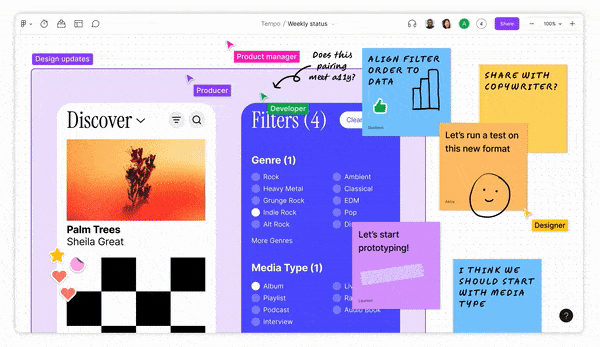Figma Transparency: When Should Non-Designers Get Access To Design Work

Recently I’ve had a few conversations with clients and colleagues about when other people on the team should get access and provide feedback on design work. While many designers dread seeing other people lurking in a half finished Figma file, PMs and developers often express a desire to be included earlier in the design process.
But even though many designers recognize the value of getting earlier feedback in theory, most designers I know still prefer to keep the curtain drawn on anything that isn’t a “complete thought,” suggesting that non-designers stick to only looking at things that have been deemed “ready for discussion.” This ensures that ideas that were never meant to be presented as a solution aren’t nitpicked and questioned unnecessarily leading to hours of wasted time explaining that that mockup is still a “work in progress.”
This might be better for designers and provide the appearance of transparency. However in my experience the problem isn’t that non-designers want to provide the same kind of feedback just at a slightly earlier stage, its that non-designers often feel like they have valuable ideas or perspective to contribute and there is a virtual wall (real or perceived) between them and the people deciding what to build and designing how it should be built. This is compounded when they are also customers or users of the product or service themselves, and are passionate about the user experience on a personal level.
When feedback is only welcomed once mockups are complete or even near-complete it does not feel collaborative. There is a natural defensiveness that occurs from both sides of the “wall.” Designers are more likely to defend their creation the closer it gets to complete, and non-designers are more likely to point out all the ways they believe this complete idea is wrong than provide ideas for what could be improved or adjusted to make it better.
The Better Way (with a few caveats)
As uncomfortable as it can be, I believe the best thing for the product is to include anyone who wants to be included right from the start of the design work. Have sketches or notes? Share them! Completed only one page of a possible feature today? Share it with notes on the decisions you made, intentions for where to go next, and any specific things that are “work in progress” for people to avoid looking too deeply at. While this may result in questions or discussion that wouldn’t be asked if you had waited for a final result to be presented, that “cost” is worth it to make everyone feel included in the creation of the product you are all building. Over time I believe people improve their design comprehension and get a better feel for what to examine or dismiss, and there is a much better "shared understanding" of what you are all trying to build and who you are building it for.
Now, this sounds great in theory, and even though I have seen it work amazingly well with the right team, it requires everyone to be on the same page and that isn’t always the case.
First, it requires designers who have strong communication skills and can describe and explain their design decisions. If you lack the ability to explain and defend the design choices you make, your work will feel more like art and criticism of that work will feel like personal attacks instead of just an honest discussion of how to achieve the most optimal solution to a problem.
Second, it requires non-designers to understand the design process and want to participate as a designer. Many non-designers think that designers are just operating from a place of personal preference and it’s just a matter of whose personal preference “wins” (and if they’ve worked with sub-par designers, they wouldn’t be wrong!). But a good product designer is actively working to remove personal preference and bias from their work, put themselves in the end user’s shoes and apply common usability principles to increase the chances that the feature will have maximum usability. Early feedback is not helpful if it’s just more people pushing a personal agenda, but if it is a collection of people all bringing their knowledge and perspective to the table in an effort to find the best solution to the problem, it is incredibly powerful.
Ultimately, you need to adapt to the situation for the best outcome. As much as I believe you should always push to include everyone early and often, and you should put in the time to teach and guide people who aren’t there yet but show interest, the reality is sometimes you work with people on a team who don’t truly want the responsibility of thinking and acting like a true product designer. Start by challenging yourself to share your work at an uncomfortable rate and iterate as you go. Some people just need a little coaching or guidance to provide valuable input and insight, while others may actually learn they are not as interested in participating and are ok with only spending time on complete thoughts.

